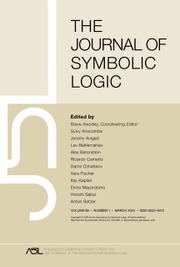No CrossRef data available.
Article contents
DP AND OTHER MINIMALITIES
Published online by Cambridge University Press: 11 April 2025
Abstract
A first-order expansion of  $(\mathbb {R},+,<)$ is dp-minimal if and only if it is o-minimal. We prove analogous results for algebraic closures of finite fields, p-adic fields, ordered abelian groups with only finitely many convex subgroups (in particular archimedean ordered abelian groups), and abelian groups equipped with archimedean cyclic group orders. The latter allows us to describe unary definable sets in dp-minimal expansions of
$(\mathbb {R},+,<)$ is dp-minimal if and only if it is o-minimal. We prove analogous results for algebraic closures of finite fields, p-adic fields, ordered abelian groups with only finitely many convex subgroups (in particular archimedean ordered abelian groups), and abelian groups equipped with archimedean cyclic group orders. The latter allows us to describe unary definable sets in dp-minimal expansions of  $(\mathbb {Z},+,S)$, where S is a cyclic group order. Along the way we describe unary definable sets in dp-minimal expansions of ordered abelian groups. In the last section we give a canonical correspondence between dp-minimal expansions of
$(\mathbb {Z},+,S)$, where S is a cyclic group order. Along the way we describe unary definable sets in dp-minimal expansions of ordered abelian groups. In the last section we give a canonical correspondence between dp-minimal expansions of  $(\mathbb {Q},+,<)$ and o-minimal expansions
$(\mathbb {Q},+,<)$ and o-minimal expansions  ${\mathscr R}$ of
${\mathscr R}$ of  $(\mathbb {R},+,<)$ such that
$(\mathbb {R},+,<)$ such that  $({\mathscr R},\mathbb {Q})$ is a “dense pair.”.
$({\mathscr R},\mathbb {Q})$ is a “dense pair.”.
Information
- Type
- Article
- Information
- Copyright
- © The Author(s), 2025. Published by Cambridge University Press on behalf of The Association for Symbolic Logic


